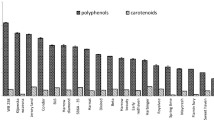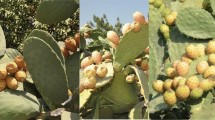Summary
The variability of the nutritional components of pejibaye fruit is fairly high and provides the impetus for further studies. These should be directed primarily toward the discovery of the highest possible carotene content associated with the least spines on the trunk.
The pejibaye, apparently, is frequently and probably obligatorily outcrossing, and the farmers almost always plant seed when they reproduce the tree. Therefore, good reason exists for the diversity we find. According to the correlation matrix calculated here, we have little hope of finding vitamin A on the basis of components which are simpler to assay than the direct carotene analysis. Among other characteristics, not readily measurable for statistical purposes, we find that the red fruits contain the highest amount of carotene. Subsequent to the analysis recorded here, a pejibaye with rare qualities has been discovered. Those very few trees with fruits that produce the red oil upon boiling may be expected to supply large amounts of carotene when they are analyzed, despite the lack of correlation between fat and carotene.
Similar content being viewed by others
References
Burgos, C, Mario. 1942. El Pejibaye. Revista Universitaria (Costa Rica),1(2): 22–30.
de J. Vargas Bejarano, Salustio, 1942. Investigacion de Carotena en el Maiz amarillo y en el Pejibaye. Thesis at Universidad de Costa Rica, 12 p.
Goldblith, S. A., & B. S. Harris. 1948. Estimation of ascorbic acid in food preparations. Anal. Chem.20: 649–651.
Góngora y López Jose, and Norton Young López. 1953. Tabla de Composición de Alimentos Colombianos. Instituto Nacional do Nutrición, Bogota, pp. 35 y 51. (as noted in Patiño, 1958, p. 330).
Guilbert, H. E. 1934. Determination of carotene as a means of estimating the vitamin A value of forage. Ind. Eng. Chem. Anal. Ed.6: 452–454.
Johannessen, Carl L., 1966. Pejibaye Palm: Yields, Prices and Labor Costs, Econ. Bot.20(3): 302–315.
Patiño, Victor Manuel. 1958. El Cachipay o Pijibay (Guilielma gasipaes Bailey), y su papel en la cultura y en la economía de los pueblos Indígenas de America intertropical 2nd parteAmérica Indigena, XVIII, (4): 299–332.
Peterson, W. J., J. S. Hughes, & H. F. Freeman. 1937. Determination of carotene in forage. A modification of the Guilbert method. Ind. Eng. Chem. Anal. Ed.9: 71–72.
Popenoe, Wilson, & Jimenez, Otón, 1921, The pejibaye, a neglected food-plant of tropical America. Jour. Hered.12: 154–166.
Raymond, W. D., & Squires, J. A. 1951. Pewa or peach nuts from Trinidad. Colonial Plant and Animal Products.2(3): 203–205.
United States Pharmacopeia XII, 1943, First Supplement.Microbiological assay for nicotinic acid or nicotinamide.
Wu Leung, Woot-Tseun, & Flores, Marina. 1961. Food composition table for use in Latin America. Washington, D. C., U. S. Government Printing Office (0-605744), 145 p.
Author information
Authors and Affiliations
Rights and permissions
About this article
Cite this article
Johannessen, C.L. Pejibaye palm: Physical and chemical analysis of the fruit. Econ Bot 21, 371–378 (1967). https://doi.org/10.1007/BF02863164
Received:
Issue Date:
DOI: https://doi.org/10.1007/BF02863164




